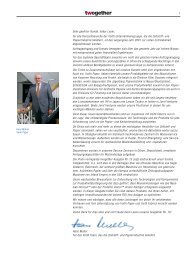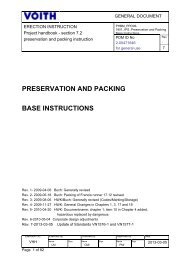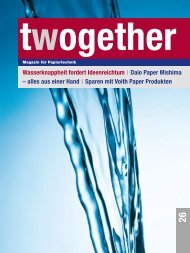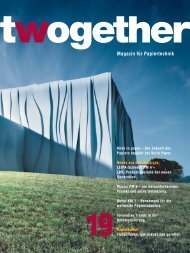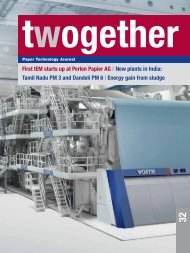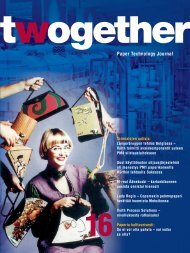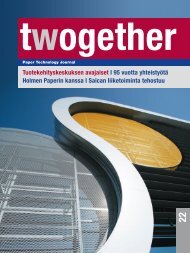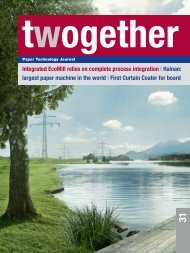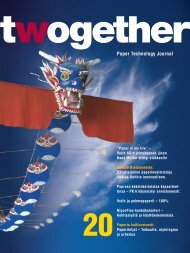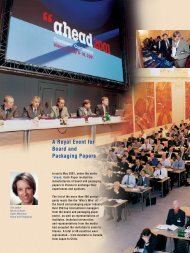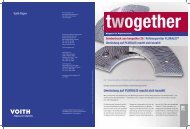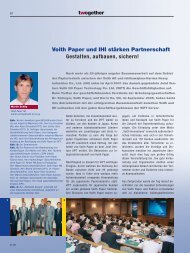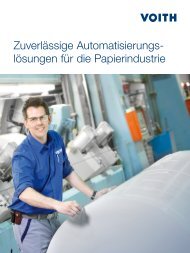Paper Technology Journal - Voith
Paper Technology Journal - Voith
Paper Technology Journal - Voith
You also want an ePaper? Increase the reach of your titles
YUMPU automatically turns print PDFs into web optimized ePapers that Google loves.
of < 5%. Through washing, some clear<br />
differences in substance losses can be<br />
seen. The differences in yield can represent<br />
8 percentage points or more. A representative<br />
yield value for the RCF plant<br />
is 58% to 60%.<br />
Personnel costs<br />
Personnel costs are determined by the<br />
following parameters:<br />
■ Plant design<br />
■ Ratio of employees with fixed job<br />
specifications to employees with<br />
variable job specifications<br />
■ Wet lap plant/drying<br />
■ Power and steam generation<br />
■ Effluent treatment.<br />
Energy costs<br />
Energy costs are mainly determined by:<br />
■ Plant design<br />
■ Availability of a drying plant for the<br />
deinked pulp and<br />
■ Availability of an existing power<br />
station.<br />
Chemical costs<br />
The chemical costs depend on plant design<br />
and finished stock requirements.<br />
Disposal costs<br />
The disposal costs for the sludge “produced”<br />
depend on the one hand on the<br />
disposal possibilities and costs and, on<br />
the other hand, on the possibilities for<br />
local re-utilization.<br />
Stock Preparation<br />
Freight costs<br />
Freight costs for the deinked pulp are<br />
determined by the distance from the mill<br />
using it and by its dry content.<br />
Fixed costs<br />
Due to the low land requirements and<br />
lower infrastructural needs, these costs<br />
are below those of a pulp mill. The maintenance<br />
and material costs are about the<br />
same as those for a pulp mill.<br />
Capital costs<br />
Since most plants for producing market<br />
deinked pulp (MDIP) have only recently<br />
started up and have been financed with<br />
public money, the amount of capital<br />
expenditure is known. A recent comparison<br />
produced the following specific capital<br />
costs:<br />
■ 800 US dollars per annual tonne<br />
(design capacity) for a deinked pulp<br />
plant with wet lap plant.<br />
■ 1400 US dollars per annual tonne<br />
(design capacity) for a deinked pulp<br />
plant with drying plant.<br />
Sales price<br />
It is extremely difficult to give the latest<br />
representative sales prices for deinked<br />
pulps, the reason for this being the drop<br />
in prices for virgin fibres. The market<br />
price for wood-free deinked pulp is generally<br />
oriented on southern hardwood<br />
chemical pulps. Due to over-capacity in<br />
the USA during 1995, 1996 and the beginning<br />
of 1997, deinked pulps had to be<br />
15<br />
sold at considerably less than the price<br />
for short fibre virgin chemical pulps. Following<br />
stabilization of chemical pulp<br />
prices, it is expected that deinked pulp<br />
prices will stabilize, too. In the longterm,<br />
UK <strong>Paper</strong> expects the DIP price to<br />
stabilize around 100 US dollars under the<br />
average price for northern long fibre<br />
chemical pulps. An additional price reduction<br />
can be expected for wet lap pulp.<br />
Cost comparison for various MDIP plants<br />
A recent study in which an independent<br />
institute compared 17 wood-free deinked<br />
pulp plants showed the RCF plant of UK<br />
<strong>Paper</strong> to be the plant with the most<br />
favourable cost structure.<br />
The advantages of the Kemsley plant lie<br />
in the low freight costs due to the ideal<br />
local situation as well as in the low personnel<br />
and disposal costs. Yield is comparable<br />
with that of other similar plants.<br />
The costs for process chemicals, fixed<br />
costs and personnel costs are comparable<br />
with those of other wet lap plants.<br />
The more recent, large deinked pulp<br />
plants with drying plants are very costintensive<br />
as regards operation and capital<br />
investment. Financial difficulties are<br />
therefore to be expected during phases<br />
of over-capacity. Provided the smaller,<br />
less capital intensive deinked pulp systems<br />
with wet lap plant can satisfy the<br />
demands of the writing and printing paper<br />
manufacturers and freight charges<br />
can be kept within limits, operation in<br />
the profit zone can be expected.



